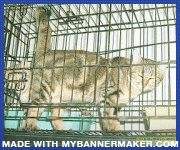Artikel kali ini pula berkenaan masalah-masalah yang sering berlaku pada bulu arnab, yang kadang-kala kita sangkakan disebabkan oleh masalah kurap sahaja.
by Dana Krempels, Ph.D.
Some unfortunate rabbits seem to shed all the time. This may be due to inbreeding causing a problem with the normal genetic response to day length and other seasonal cues, or to too much artificial lighting disrupting the rabbit's normal Circadian rhythms. In any case, when your rabbit sheds, even during a normal shed cycle, there are certain things that you, the caregiver, can do to make sure the shed is uneventful and comfortable for your bunny.
When a fastidious self-grooming animal such as a rabbit undergoes a shedding cycle, it's almost inevitable that some fur is going to be swallowed. Although rabbits do not typically get "hairballs" (with the exception of some of the long-haired breeds), ingested hair can be difficult to pass, and can make the bunny uncomfortable. The goal of the rabbit caregiver should be to reduce the amount of ingested hair as much as possible.
Correct Diet Will Help Push Ingested Hair Through the Intestine
Intestinal motility problems arise when a rabbit does not eat sufficient rough fiber and does not drink enough liquid to keep the intestinal contents well hydrated. Dehydrated intestinal contents are prone to form desiccated, difficult-to-pass masses of food and hair, and the situation can be made worse if the bunny is shedding/molting.
During a molt, it's important that your bunny have free-choice, unlimited fresh grass hay, plenty of fresh, wet greens, and plenty of fresh, clean water to drink. A heavy, ceramic crock is better than a sipper water bottle, as a rabbit will usually drink more from a bowl, and in a more natural position. Hay, wet greens and water will all keep the intestinal contents well-hydrated and easy to pass, and the bunny far less likely to suffer from any intestinal irritation related to ingestion of hair.
Don't worry if you see your bunny leaving "strings of pearls": fecal pellets strung together with twists of fur. If the fur is coming out, then things are working fine, though you might want to do more grooming to reduce the amount of hair the bunny swallows. Here's how.
Grooming Off Loose Fur Will Help Prevent Fur Ingestion
Daily grooming will help prevent discomfort during a shed cycle. A soft-tipped, wire brush or small, very fine-toothed flea comb will help you gently comb out loose fur. Careful plucking of loose fur tufts is also fair play, though many bunnies will object, and need to be groomed on a secure surface where s/he can't run off in protest.
A good way to remove loose fur that's not tufting is the Wet Hand Rubdown. Moisten your hands, and gently rub the bunny backward and forward over the entire length of the body. Loose fur will stick to your moist hands and form a thick sheet. To remove the felt, simply rub your hands together to make a roll, throw it away, and repeat the procedure until your bunny's loose fur is mostly removed.
In some cases, a bunny will undergo what we call a "coat blow," shedding great clumps of fur all at once, and sometimes even leaving small bald patches. If the bunny is healthy, within a few days the bald patches will become pigmented, and then start to grow hair. If this doesn't happen, however, the fur loss may be due to one of several disease processes, and you should consult your trusted rabbit veterinarian for help in determining what the problem is, and how to appropriately treat it.
If you do not already have a veterinarian who is experienced and familiar with rabbit medicine, please use the House Rabbit Society Veterinarian Listing to find one near you.
- Parasite Infestations (fleas, lice, mites, fungus):
- Sarcoptes scabei or Chorioptes sp. (mange mites)
- Cheyletiella parasitivorax (fur mites) or Leporacus gibbus
- Psoroptes cuniculi (ear canker mites)
- Ornithonyssus spp. (Tropical Rat Mite or Feather Mite)
- Trixacarus caviae (Burrowing Mange Mite)
- Ringworm Fungus (Microsporum spp.)
- Saliva Burn (fur loss under the chin, on the dewlap, and on the chest)
- Urine Burn (fur loss on the hindquarters only)
- Bacterial Infection
- False Pregnancy
- Overgrooming by self or bunny partner
- Fighting among rabbits
- Hormone Imbalance
Dental Problems:
Urinary Tract Disorders:
Other Health Problems:
Fur loss can be caused by several different kinds of mites that can infest rabbits, including mange mites (Sarcoptes spp.), fur mites (Cheyletiella spp. and Leporacus spp.), and mites causing ear canker (Psoroptes spp. or Chorioptes spp.) and other problems (see below). A severe flea infestation also can cause such severe itching that the rabbit scratches off his own fur. Fortunately, there are excellent, modern medications available that are safe for rabbits, and will kill these parasites quickly, as described at the end of this section. rabbits.
Tropical Rat (and Pigeon) Mites
Rabbit-Safe Remedies for Mites, Fleas, and Ticks
Similarly, although mineral oil or topical ointments instilled in the ears are sometimes suggested as treatments for ear mites, they are not effective in the long term, and may make things worse, if there is underlying infection. For this reason alone, it is wise to always seek the help of a rabbit-savvy veterinarian to treat any of the problems listed below, and not try to diagnose or treat them yourself.
DO NOT, under any circumstances, use Frontline (fipronil) on your rabbit! Although this flea control product is apparently safe for other species, it has been implicated in many rabbit deaths due to severe neurological side effects. Check the package labeling, and you will see that the manufacturer now states that their product should not be used on rabbits.
We have found selamectin to be the most effective medication for persistent flea and mite infestations, and particularly for fur mites. Mange-afflicted little Tyler--shown below as "before", "during" and "after" selamectin treatment below--would agree!



Other Possible Causes of Fur Loss
Parasites are not the only reason your rabbit may be losing fur. Here are some other possibilities.
Fur Loss Around the Mouth and Under the Chin: Dental Problems!
Signs like this are almost surely due to molar spurs or other dental problems such as a molar abscess. These will make the bunny drool. Since saliva is caustic, it burns the skin, making the wet area itchy and sore, and causing the fur to fall out. Some rabbits will actually chew at the irritated area so much that they develop open sores.
Although just about any rabbit can get molar spurs and other dental problems, they are more prevalent in short-faced breeds such as lops and dwarf rabbits, as well as in rabbits five years or older.
The solution to this problem is to find a very experienced rabbit vet who can do a deep oral exam to detect any molar spurs (some sensitive rabbits will show these signs even from very small spurs), and file them smooth, as necessary. If no spurs are visible, then head radiographs may be necessary to see if there are any signs of tooth rooth infection or other mouth problem that's causing the bunny to drool.
Fur loss around the rear end and belly: Urine Burn
In some rabbits, fur loss is restricted to the area between the hind legs, around the tail, and sometimes up the belly and onto the feet. If there is no fur loss anywhere else on the body, then the possibility that a urinary tract problem (e.g., urinary tract infection, bladder sludge, bladder stone) causing urine leakage should be considered. It is important to learn a little about specific urinary tract disorders in rabbits, so that you will know what questions to ask your veterinarian.
Like saliva, urine is caustic. If it collects in the fur, it will burn the underlying skin, causing fur to fall out and the skin to become red and raw. While the veterinarian is sorting out the cause of the urine leakage, and while medications are starting to do their work, you can keep your bunny comfortable and start the skin healing and fur growing back with a safe way to administer a rinse and/or dry Bunny Butt Bath. A rabbit should never be bathed completely, as this can cause so much stress as to be life-threatening. But a badly urine-burned behind must be gently cleansed, dried and protected so that the pain doesn't elicit worse problems, such as GI slowdown, or ileus.
If your vet diagnoses bacterial skin infection, the bunny may need to be shaved down over the affected areas, and appropriate medications administered, preferably guided by the results of a culture and sensitivity test to see which rabbit-safe antibiotic will be most effective against the particular pathogen your bunny has.
Nest building due to false (or real) pregnancy
If your bunny is female and unspayed, you may witness her pulling tufts of fur from her chest, belly and sides, then rushing off to line a nest she's made of household items (such as the stuffing of your couch and pillows). If there's no way your bunny could be pregnant except by Immaculate Conception, then she's having a false pregnancy. This means it's time to have her spayed to avoid the risk of uterine cancer, mammary cancer, and other health problems associated with an intact female reproductive system that's not being used.
If your bunny is actually pregnant, please see our section on how to care for a surprise litter of babies, and how to avoid this in the future.
Overgrooming by a bonded companion
Tufting/fighting among rabbits
If the bunnies are fighting, it's important to have them all spayed and neutered, for their health and longevity, and your peace of mind. Severe fighting should be absolutely prevented, as serious injuries can result, not to mention permanent hatred between the warring bunnies. For tips on how to bond bunnies and how to mend broken bunny bonds, please read this information from the House Rabbit Society.
I hope this helps you on the road to determining the cause of fur loss in your companion rabbit. Please feel free to email me if you have questions.



















No comments:
Post a Comment